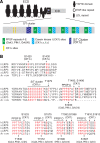Regulation of Lrp6 phosphorylation
- PMID: 20229235
- PMCID: PMC11115861
- DOI: 10.1007/s00018-010-0329-3
Regulation of Lrp6 phosphorylation
Abstract
The Wnt/beta-catenin signaling pathway plays important roles in embryonic development and tissue homeostasis, and is implicated in human disease. Wnts transduce signals via transmembrane receptors of the Frizzled (Fzd/Fz) family and the low density lipoprotein receptor-related protein 5/6 (Lrp5/6). A key mechanism in their signal transduction is that Wnts induce Lrp6 signalosomes, which become phosphorylated at multiple conserved sites, notably at PPSPXS motifs. Lrp6 phosphorylation is crucial to beta-catenin stabilization and pathway activation by promoting Axin and Gsk3 recruitment to phosphorylated sites. Here, we summarize how proline-directed kinases (Gsk3, PKA, Pftk1, Grk5/6) and non-proline-directed kinases (CK1 family) act upon Lrp6, how the phosphorylation is regulated by ligand binding and mitosis, and how Lrp6 phosphorylation leads to beta-catenin stabilization.
Figures



References
-
- Clevers H. Wnt/beta-catenin signaling in development and disease. Cell. 2006;127:469–480. - PubMed
-
- Logan CY, Nusse R. The Wnt signaling pathway in development and disease. Annu Rev Cell Dev Biol. 2004;20:781–810. - PubMed
-
- Klaus A, Birchmeier W. Wnt signalling and its impact on development and cancer. Nat Rev Cancer. 2008;8:387–398. - PubMed
-
- van Amerongen R, Mikels A, Nusse R (2008) Alternative Wnt Signaling Is Initiated by Distinct Receptors. Sci Signal 1, re9 - PubMed
-
- Gordon MD, Nusse R. Wnt signaling: multiple pathways, multiple receptors, and multiple transcription factors. J Biol Chem. 2006;281:22429–22433. - PubMed
Publication types
MeSH terms
Substances
LinkOut - more resources
Full Text Sources
Other Literature Sources
Research Materials

